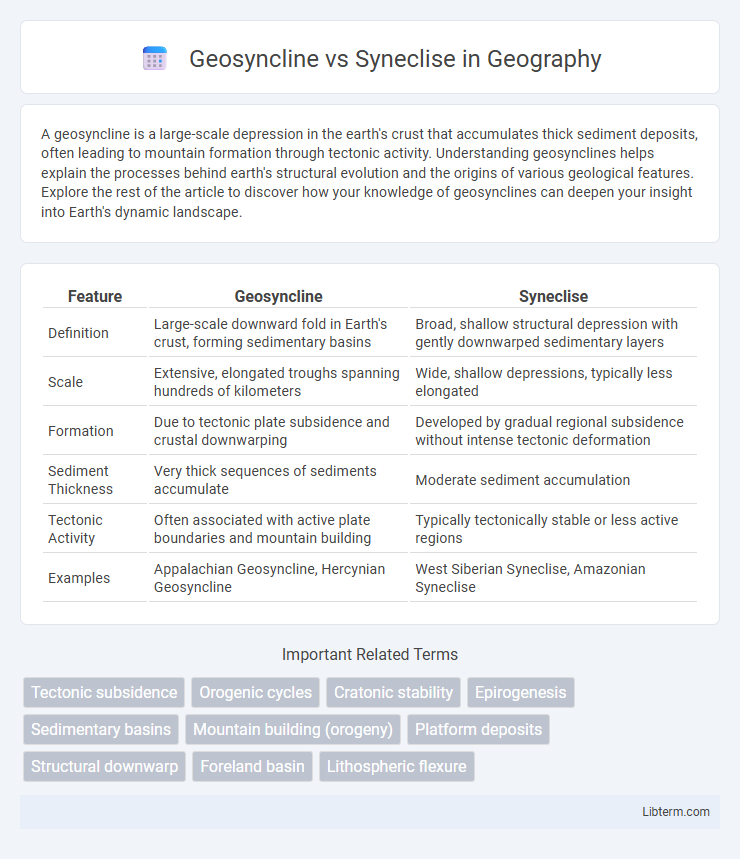A geosyncline is a large-scale depression in the earth's crust that accumulates thick sediment deposits, often leading to mountain formation through tectonic activity. Understanding geosynclines helps explain the processes behind earth's structural evolution and the origins of various geological features. Explore the rest of the article to discover how your knowledge of geosynclines can deepen your insight into Earth's dynamic landscape.
Table of Comparison
| Feature | Geosyncline | Syneclise |
|---|---|---|
| Definition | Large-scale downward fold in Earth's crust, forming sedimentary basins | Broad, shallow structural depression with gently downwarped sedimentary layers |
| Scale | Extensive, elongated troughs spanning hundreds of kilometers | Wide, shallow depressions, typically less elongated |
| Formation | Due to tectonic plate subsidence and crustal downwarping | Developed by gradual regional subsidence without intense tectonic deformation |
| Sediment Thickness | Very thick sequences of sediments accumulate | Moderate sediment accumulation |
| Tectonic Activity | Often associated with active plate boundaries and mountain building | Typically tectonically stable or less active regions |
| Examples | Appalachian Geosyncline, Hercynian Geosyncline | West Siberian Syneclise, Amazonian Syneclise |
Introduction to Geosyncline and Syneclise
Geosynclines are large-scale linear troughs or depressions in the Earth's crust that accumulate thick sedimentary deposits, playing a crucial role in mountain-building processes through subsidence and subsequent orogeny. Syneclises, in contrast, are broad, shallow depressions characterized by gently downwarped sedimentary layers without significant tectonic deformation. Understanding the formation and characteristics of geosynclines and syneclises is essential for exploring sedimentary basin development and tectonic evolution of continental crust.
Definition of Geosyncline
Geosyncline is a large-scale, elongated trough in the Earth's crust that accumulates thick sedimentary deposits, often serving as a precursor to mountain formation through tectonic processes. Unlike a syneclise, which is a broad, shallow structural basin with gentle folds and minimal tectonic disturbance, a geosyncline involves significant subsidence and deformation. Understanding geosynclines is crucial for interpreting the evolution of orogenic belts and sedimentary basin development.
Definition of Syneclise
Syneclise is a large, shallow, and extensive depression or basin in the Earth's crust, typically characterized by stable sedimentary rock layers and gentle structural folding. Unlike a geosyncline, which is a deep, elongated trough associated with intense tectonic activity and mountain-building processes, a syneclise represents a broad subsiding region with minimal deformation. Syneclises serve as significant sediment accumulation zones, often forming the structural basis for petroleum reservoirs and complex sedimentary basins.
Historical Development of Geosyncline Theory
The historical development of geosyncline theory began in the late 19th century with the work of Eduard Suess, who introduced the concept to explain large-scale crustal depressions filled with sedimentary rocks. Geosynclines were later elaborated by Leopold Kober and James Dwight Dana to describe regions undergoing subsidence and mountain formation due to sediment thickening and tectonic forces. The theory gradually gave way to plate tectonics in the mid-20th century as geosyncline concepts were reinterpreted within the framework of advancing knowledge on lithospheric plate interactions.
Geological Characteristics of Geosynclines
Geosynclines are large-scale, elongated troughs in the Earth's crust filled with thick sequences of sedimentary and volcanic rocks, often associated with intense folding, faulting, and tectonic activity during mountain-building processes. They exhibit significant subsidence and sediment accumulation due to crustal downwarping, contrasting with the stable, less-deformed nature of syneclises, which are broad, gently subsiding basins. The geological characteristics of geosynclines include complex structural deformation, metamorphism, and magmatism resulting from convergent plate interactions and orogenic events.
Geological Features of Syneclises
Syneclises are large, broad structural depressions characterized by extensive sedimentary rock sequences with gentle to moderate regional subsidence, often spanning hundreds of kilometers. Unlike geosynclines, which are elongated and tectonically active troughs, syneclises display relatively stable geological environments with thick accumulations of Paleozoic to Mesozoic sediments and minimal folding or faulting. These features support the gradual infilling of sedimentary basins crucial for hydrocarbon reservoirs and groundwater aquifers within stable continental interiors.
Differences between Geosyncline and Syneclise
Geosynclines refer to large-scale, elongated troughs in the Earth's crust where thick sedimentary deposits accumulate, often associated with mountain-building processes, while syneclises are broad, shallow basins with gentle subsidence and relatively stable conditions. Geosynclines typically exhibit active tectonic deformation and crustal thickening, whereas syneclises show minimal tectonic disturbance and serve as stable sedimentary basins. The key difference lies in their tectonic activity and structural complexity, with geosynclines being dynamic zones prone to orogeny and syneclises representing more stable, subsiding regions.
Significance in Tectonic Evolution
Geosynclines represent large-scale, linear troughs of sediment accumulation crucial for understanding the early stages of mountain-building processes in tectonic evolution. Syneclises are broad, gently downwarped sedimentary basins that indicate prolonged subsidence without intense deformation, reflecting stable continental interiors in tectonic terms. The distinction between geosynclines and syneclises is significant for interpreting past tectonic environments and the mechanisms driving crustal deformation and basin development.
Examples of Geosynclines and Syneclises Worldwide
The Appalachian Geosyncline in North America and the Hercynian Geosyncline in Europe exemplify classic geosynclines characterized by sediment accumulation and tectonic subsidence, which contributed to mountain formation during the Paleozoic era. In contrast, the Russian Platform features prominent syneclises such as the Dnieper-Donets Syneclise, representing large, stable sedimentary basins with gentle subsidence over extended geological periods. These examples highlight the distinction between dynamic geosynclines involved in orogenesis and more stable syneclises that act as sedimentary traps within cratonic regions.
Conclusion and Summary
Geosynclines represent large-scale, elongated troughs in the Earth's crust that accumulate thick sedimentary deposits and are primary sites for mountain-building processes, while syneclises are similar downwarped regions but typically broader, less tectonically active, and with gentler structural deformation. Both concepts explain sedimentation patterns and crustal subsidence, yet geosynclines are associated with intense orogenic events, contrasting with the more stable and extensive sediment accumulation characteristic of syneclises. Understanding the differential tectonic activity and sedimentation in geosynclines versus syneclises is crucial for interpreting regional geology, resource exploration, and tectonic history.
Geosyncline Infographic

 libterm.com
libterm.com